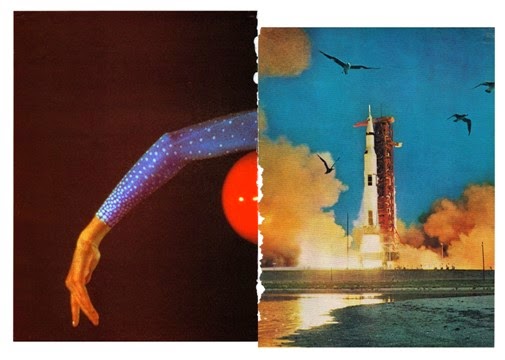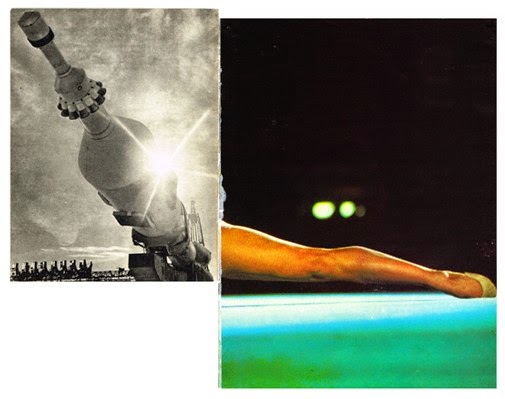
Aikaterini Gegisian: Is This Why I Cannot Tell Lies? @ Tintype Gallery
Femininity and nature, athletics and space technology, dreams and male prostitution; these are some of Aikateri Gegisian’s points of exploration featuring in her current exhibition at Tintype Gallery. Embracing a wide spectrum of iconography, Gegisian renders her chosen narrative with assemblages of ready-made imagery, referencing the aesthetics of cinematic ‘jump-cuts’. Counterbalancing between sexuality and socio-cultural impulses, her exhibited body of work is a vibrant footage of the unconscious, manifesting the need for self and interpersonal scrutiny. Her surreal compendium is an ethogpraphical endeavour in disguise, stimulating viewers and challenging esoteric vices with an underlying humorous twist.
Aikaterini Gegisian talked to Kostas Prapoglou and Georgia Korossi about her exhibition and work:
K.P.: Your exhibition also encompasses a sound installation-dream diary and a text book on how to become a male escort. What has triggered this concept and how is this related to the consensus of the exhibited work?
A.G.: The sound piece, titled Is This Why I Cannot Tell Lies? that also gives the name to the exhibition as a whole, is composed of two voices narrating fragments from my dream diary and extracts from a textbook on how to become a male escort. The work developed alongside my wider research on how female sexuality has been expressed and represented in popular culture. During the collection of photographic material of gymnasts and space rockets (that compose the series Falling Tight), I took the decision to keep a dream diary in order to explore the space of the unconscious as a location of female desire not mediated by ideological regimes. The decision to use scenes from the dreams in the sound installation was eventually formulated when I discovered the textbook on how to become a male escort in a flea market in New York. The book, which was written in the 80s and describes in detail how to please women, provided me with a male point of view on female pleasure. In the sound piece the two points of views, the female desire as it manifests in the subconscious and the male instructions on how to bring a woman to a climax, alternate creating the feeling of a dialogue of different positions coming together in a singular space.

K.P.: How do your narratives emerge and where are your influences from?
A.G.: The exploration of narrative moments has always been part of my artistic practice. In my early work, this was expressed as an investigation on how fragments of sounds, images and texts come together to create the possibility of narrative. More recently, in my practice the idea of narrative is mostly understood as a movement in space and time, which is strongly shaped by emotional experiences. In other words, as I investigated how images (from still to moving) create movement, narrative becomes the manifestation of such movement, which allows for a set of relations to unravel. However, apart from the position that we are narrating space and time as we inhabit it, my work is also concerned with the way narratives function as part of specific ideologies, especially related to modernist projects. In a similar manner, my influences begin with the observation of everyday practices especially in the experience of the city, which is then opened up to encompass how such experiences are represented in a variety of representational regimes. Following an essayistic logic of bringing together heterogeneous material to explore how images take on different meanings depending on the ideologies that frame them, I am interested in exploring different visual languages (from folk traditions, to popular media and fine art practices). This dynamic is also reflected in the type of material I am collecting and their formal questioning that borrows from and sets against oppositional discursive and aesthetic regimes.
G.K.: What made you decide to work with collage and how does this medium relate to the sci-fi genre?
A.G.: I have always been interested in exploring the mechanisms of cinematic language and the way it breaks down to individual components as image, sound and text. My preoccupation with collage was a natural progression in understanding how expanded photographic forms influence cinematic imagination. The collage in my work becomes another manifestation of the cinematic idea of montage, as a bringing together of two or more images, in order to create new experiences or narratives. In the series Falling Tight, the juxtaposition of different found material is expressed not as a traditional layering of fragments of images but as a type of de-collaging. The diverse photographic materials are placed side by side, encompassing the theme of space travel but not necessarily reference the formal language of the sci-fi genre, in order to explore how the female body is literally and metaphorically placed in the pace of the future. Thus, in the work the sci-fi genre is used more as a cultural marker that signifies the possibility of movement in outer space rather than as a formal strategy.
G.K.: How do you see feminism evolving in the next 25 years?
A.G.: In the past few years my practice has embraced a strong female position, alighting and addressing both historical representations of women in diverse geographical locations but also referencing feminist artistic practices. The expression of female subjectivity for me begins with the desire to inscribe a space for the female author and repossess images of women constructed by a male imaginary. However, I would like to distance myself (and the works in the exhibition are the first attempts) from an understanding of gender relations as oppositional, from the polarisation between female and male bodily and emotional experiences. The radical potential of future feminism for me lies in the reimagining of gender relations and the embracing of fluid and transformational identities.
